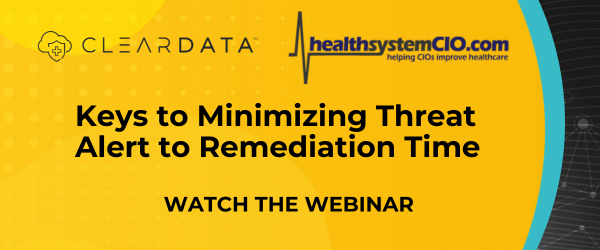A CISOs Take—Why MTTR Matters in Healthcare Cybersecurity and How It Impacts Patient Safety
At a Glance: Why MTTR Matters in Healthcare Cybersecurity
- MTTR (Mean Time to Remediation) measures how fast healthcare organizations detect and resolve cybersecurity threats—faster response = safer patients.
- Delays in remediation can disrupt clinical workflows, block EHR access, and jeopardize patient safety during attacks like ransomware.
- Shortening MTTR requires the right cybersecurity tools, trained experts, and a proactive strategy tailored to the healthcare cloud environment.
Picture this: You oversee cybersecurity at a bustling healthcare organization. Every day, you are on the frontlines, protecting patient data from potential threats. But what happens when a cyberattack slips through the cracks? Panic sets in, and the systems in place to protect and secure patient safety is at risk. It is vital to immediately respond and remediate the threat.
How Mean Time to Respond/Remediate (MTTR) comes into play
Last year, I joined the panel discussion “Keys to Minimizing Threat Alert to Remediation Time,” together with healthsystemCIO and fellow panelists Kim Alkire, System Director at Cyber Wellness (acting CISO) at Health First, and Adam Zoller, CISO at Providence.

In this discussion, we stressed the importance of Mean Time to Respond/Remediate (MTTR), a critical metric in the fight against cyber threats. It is the average time it takes to fix a cybersecurity issue once it’s been detected. The average time to remediate critical cybersecurity vulnerabilities in healthcare can vary widely depending on several factors, such as the nature of the vulnerability, the complexity of the healthcare organization’s IT infrastructure, the availability of resources, and the effectiveness of the organization’s cybersecurity practices.
The Role of Mean Time to Remediation (MTTR)
Mean Time to Remediation (MTTR) is a critical healthcare cybersecurity metric that measures how quickly a threat is resolved after detection. In healthcare environments, MTTR for critical vulnerabilities can vary based on factors like the type of cyber threat, IT infrastructure complexity, available security resources, and the organization’s overall incident response capabilities.
Why do we care about MTTR and how does it relate to patient safety?
For starters, a cyberattack can wreak havoc on patient safety by disrupting hospital operations. If doctors can’t access patient records due to a ransomware attack and are left in the dark, then they are unable to provide the care their patients need.
Additionally, corrupted or altered medical records only further jeopardize patient safety and treatment. The longer it takes to resolve the issue, the greater the risk to patient safety.
Therefore, it’s vital for healthcare organizations to aim for a shorter MTTR. By resolving issues quickly, they minimize disruptions to their services and protect PHI.
But how do healthcare organizations achieve a shorter MTTR?
Healthcare providers need to invest in advanced cybersecurity tools and the expertise required to deploy and operationalize these tools. The sooner a threat is identified, the quicker it can be neutralized. Second, they should conduct regular cybersecurity training for their staff to ensure everyone knows how to respond to potential threats.
Healthcare providers must not only invest in advanced cybersecurity tools, but must hire experts with the skills to deploy and implement these resources effectively. New technology is nothing without the skills to leverage them.
Additionally, it’s vital to foster a culture of continuous improvement. Relying on reducing MTTR alone is insufficient. CISOs should regularly review their cybersecurity protocols based on the latest best practices, threat intelligence, and evaluate whether there is an opportunity to partner with a highly skilled and specialized cloud cybersecurity vendor.
MTTR is a crucial metric in healthcare cybersecurity. By prioritizing a shorter MTTR, healthcare organizations can protect patient data, maintain operational efficiency, and ensure patient safety.
If you oversee cybersecurity at a healthcare organization, it’s time to step up your game and make MTTR a top priority. MTTR reflects a healthcare organization’s commitment to safe and quality patient care.
If Nothing Else, Remember
- Massive technological investments are futile if you don’t invest in the expertise to utilize them.
- The faster you resolve a cybersecurity threat, the safer you keep your patients.
Every second counts. Reducing MTTR isn’t just about improving cybersecurity metrics—it’s about protecting patient safety, ensuring continuous care, and preserving trust.
Now is the time to take a proactive stance: secure your data, minimize downtime, and partner with experts who can help you resolve threats faster and more effectively.
Talk to an expert
By Chris Bowen, Founder & Chief Information & Security Officer
FAQ
How can healthcare organizations reduce their MTTR?
To reduce MTTR, healthcare teams should:
- Implement real-time threat detection and MDR solutions
- Automate response workflows wherever possible
- Train IT and clinical staff on how to report suspicious activity
- Partner with experienced cloud cybersecurity providers
What is a good MTTR benchmark for healthcare organizations?
While it varies, many experts recommend aiming for an MTTR of under 30 days for critical vulnerabilities. However, best-in-class organizations using automated tools and managed detection and response (MDR) services often resolve threats in hours to days, not weeks.
Why is reducing MTTR important for hospitals and healthcare systems?
A faster MTTR reduces the time a threat actor can dwell in your network, which minimizes the risk of data breaches, ransomware impact, and operational downtime. In healthcare, even short delays can disrupt patient care, EHR access, and regulatory compliance.
What is MTTR in healthcare cybersecurity?
MTTR, or Mean Time to Remediation, refers to the average time it takes a healthcare organization to detect, respond to, and resolve a cybersecurity incident. It’s a critical metric because delayed remediation can put patient data, compliance, and even lives at risk.
Now is the time to take a proactive stance: secure your data and minimize downtime



